Modifying guide Ford Focus ST170 Mk1
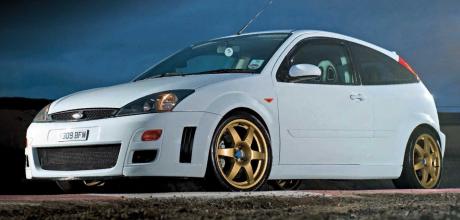
The Focus ST170 is widely revered as a fantastic handling car with a smooth and rev-happy 2.0-litre engine that delivered plenty of smiles-per-mile. But that doesn’t mean it can’t be made even better...
Words JAMIE KING
Photos ADE BRANNAN
MODIFYING GUIDE: MK1 FOCUS ST170
How to extract the best from the hot Mk1 that wasn’t an RS.
The Mk1 Focus was a bit of a turning point for Ford; before its arrival in 1998, Blue Oval hatchbacks were something of a handful when the road got twisty. Yes, they were fast. And yes, they could be exciting. But when the control blade-equipped Focus arrived, it showed Ford fans what they had been missing. Previous fast Fords – even including the mighty Cosworth range – had always been a bit antiquated when it came to chassis design and suspension setup. And the Mk1 Focus put that right. It was the genesis of the playful handling traits that have characterised fast Fords since – the Fiesta STs, Focus ST, and Focus RS generations all built on the success of the Mk1 Focus platform. The only thing was the original versions available at launch weren’t what you’d call ‘fast’. For that, we had to wait until 2002, when, typically, two fast Focus models arrived in quick succession. The ST170 was the first, developed by Ford’s SVE (Special Vehicle Engineering) Team it epitomised what a fast, fun, and practical hot hatch should be. The 2.0-litre Zetec engine was tuned to give 171bhp and mated to a close-ratio six-speed gearbox, and the chassis was further tweaked to deliver impressive performance both on the street and the circuit.
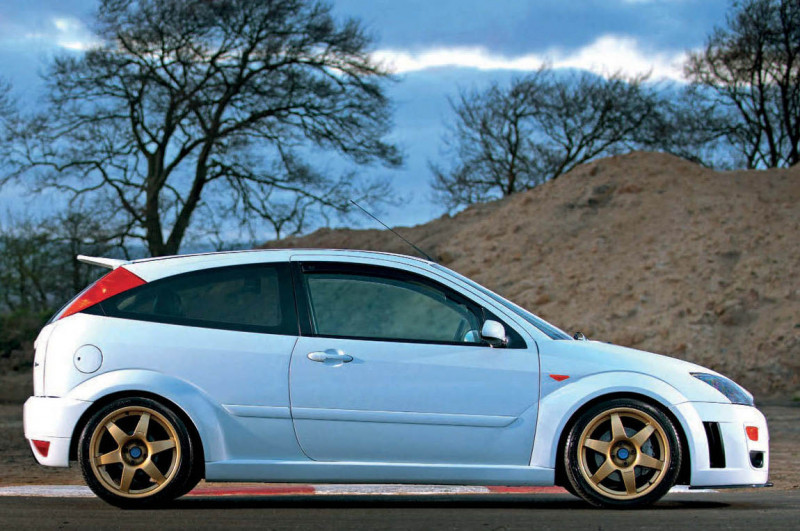
The ST170’s problem didn’t come from Japanese rivals like the Civic Type R, but from within the Dagenham garage, in the shape of the Focus RS. The more aggressive RS stole the headlines – especially as it brought the return of the Rallye Sport brand – despite being a completely different prospect aimed at a totally different type of buyer.
But, twenty years on, car fans all over the world recognise the RS, although it takes a proper enthusiast to spot the ST170. In standard guise they’ll never fail to put a smile on your face, but with just a handful of well-placed upgrades, you can turn the understated ST into something really special.
INTERIOR
Aimed at the more discerning market, the ST170 was better equipped than even the RS version. There were no sponsorship partners to keep happy with fake branding and marketing exercises with the ST, so the guys and gals at SVE simply selected the best components for the job. Well, they were on the options list, at least. If your ST has the Custom Pack, it’ll have leather Recaros, and there is very little need to replace them. If yours hasn’t, the Recaros are an easy and worthwhile upgrade. Or, you could look to add some modern alternatives. We’ve seen Mk1 RS seats fitted to ST170s before, but there are better options available these days. We’ve also seen Mk1 RSs with the Sportster CS buckets from a Mk2 Focus RS modified to fit, and they look fantastic. Therefore, it stands to reason they would look equally at home in the ST too, but they aren’t cheap. Or there is a selection of performance upgrades available from specialists such as Corbeau (who also offer custom subframes to make installation a breeze), but our advice would be to avoid anything with a fixed back or too ‘motorsporty’ for a fast-road ST. Instead, look at Clubsport-type options and you’ll be on to a winner.

EXTERIOR
The ST170 is a good-looking car that’s aged gracefully. The New Edge design still looks surprisingly sharp and modern, but some may find it a bit too plain – especially when parked alongside the wide-boy Mk1 RS and loudmouth bright orange Mk2 Focus ST.
If you prefer a subtle look, then keeping it simple and adding personal touches like dark rear lights can work well. On the other hand, if you want to make a statement, you have many options depending on your taste. You can create an RS-style replica (just don’t paint it blue!), but if you prefer something more original, the American SVT Focus (the USA version of the ST170) had revised front and rear bumpers that can make a noticeable difference to the appearance of the car, if you can find a set anywhere.
Some may argue — us included — that the understated looks of the ST170 are one of its strengths, and therefore wouldn’t recommend anything too outlandish or garish. The number one rule here is to keep it subtle.
ENGINE
Let’s start by addressing the elephant in the room, or the engine bay in this case. Despite stating ‘Duratec ST’ on the cam cover, the ST170’s 2.0- litre powerplant is, in fact, a Zetec engine – the Duratec badging was merely a marketing ploy at the time.
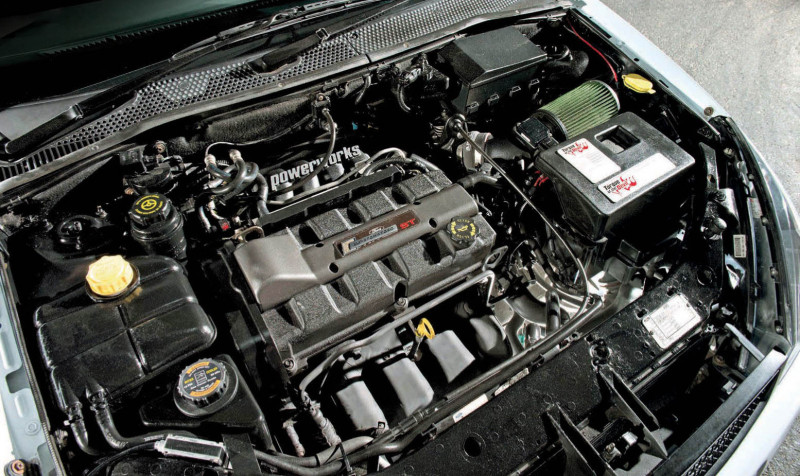
But that’s no bad thing, as the Zetec is a fantastic engine. And the ST170 version is the cream of the crop when it comes to tuned naturally aspirated Zetecs. When you consider the standard 2.0-litre Zetec on which it’s based only produces 130bhp, the extra 40bhp – a 30% increase – offered by the ST170 shows how seriously Ford took development. Boasting goodies such as high-compression pistons, a big-valve cylinder head, lairy cams, and a large-bore exhaust as standard means there’s not a lot of room left for huge gains when it comes to tuning the ST170. But there are a few…
The first of which is a simple vernier timing pulley on the exhaust cam. The inlet uses variable valve timing to deliver the power when needed but also keep the emissions low enough to meet the requirements of the time. That means the exhaust cam timing is something of a compromise to work well at both ends of the spectrum – by fitting an adjustable cam pulley and setting the exhaust cam timing with power in mind over emissions, as much as 10-12bhp can be gained from a very simple upgrade.
The usual tuning route of adding an exhaust and air filter may help to release a bit more power but don’t expect miracles. The main benefit is a vastly improved soundtrack, but from a tuning perspective, the Ford stuff is already up to the job. The same goes for remaps. Unlike modern turbocharged cars where you can expect to see huge gains from revised software settings, the ST170 is already well-optimised straight out of the box. Off-the-shelf tuning handsets like the Superchips Bluefin will deliver a bit extra but don’t expect much more than around 10-12bhp gains. You could look to install even more aggressive cam profiles and further port and polish the cylinder head, but to see meaningful gains your next upgrade should ideally be a set of individual throttle bodies and a standalone aftermarket engine management system. These require a significant financial outlay but really are the key to cracking 200bhp. They’ll provide you with a very trick, screaming Zetec with an addictive and linear power delivery – perfect for the ST170’s playful chassis setup.
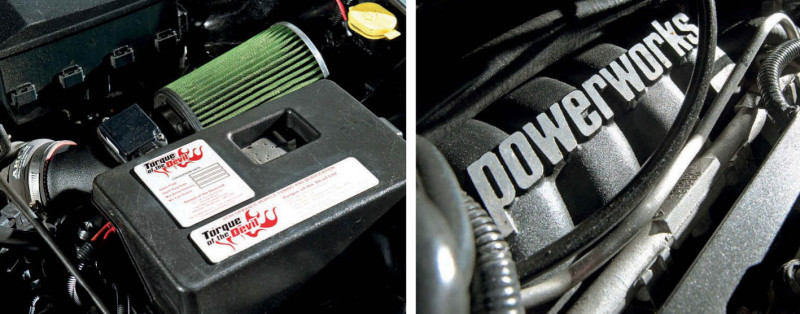
Other options include going for forced induction. The easiest and probably the most cost-effective way to do this is to swap over to a Mk1 Focus RS engine but then you are merely turning your ST in an RS replica. Another option, if you can find one, is to fit a supercharger kit – Jackson Racing over in the States made a bolt-on kit for the Zetec that, with some minor fettling, can be made to fit the ST170 too. These deliver a significant boost in power, but more importantly, retain the rawness and the linear power delivery that’s more in keeping with the ST170, and would be our preferred choice over a turbo swap.
ENGINE SWAPS
When it comes to extracting the maximum power from your Focus ST170, an engine swap could be the key. While there are a variety of upgrades available, one option stands out above the rest: a swap to the potent engine from the Focus RS.
With its turbocharger and advanced tuning, the Focus RS engine is capable of impressive power figures — some owners have pushed theirs well beyond 500bhp. Swapping an RS engine into your ST170 will ideally require access to a donor vehicle to ensure that all necessary parts are on hand, but the results will be worth it. It’s a conversion that’s been completed numerous times over the last twenty years (and not just into ST170s), so several tuners will be able to advise on exactly which parts you’ll need to complete the swap. Another consideration would be the newer EcoBoost series of engines. We’ve yet to see it done, but the 1.6-litre from the Mk7 Fiesta ST would be our pick. The 1.6 EcoBoost can trace its heritage back to the Zetec SE range, and early Mk1 Focuses were offered with the 1.6 Zetec SE so the engine architecture follows on nicely. There will undoubtedly be a few bits of custom fabrication required and you’ll need to find a friendly electronics wizard to sort out the wiring for you, but we’ve seen similar conversions successfully completed on Fiestas, and the results are incredible.
TRANSMISSION
The ST170 comes with a Getrag close-ratio six-speed gearbox, and there’s very little reason to change it. It’s a tough unit and is more than up to the task of anything you’ll get from the ST170 if sticking to n/a tuning. If you do venture down the forced induction route, the MTX75 from the RS is a relatively straightforward swap (although you may also want to add the wider flared arches, longer driveshafts, and run the wider track of the RS too), but for a screaming naturally aspirated ST170, the Getrag’s ratios are much better suited to the narrow, higher-revving powerband.
When it comes to the clutch, it’s worth noting that it can be a bit fragile under heavy pressure. For those who want to push their ST170 to the limit, we recommend upgrading to a more durable clutch. Companies like AP Racing or Helix can provide expert advice on selecting the best option for your needs. It’s important to appreciate the performance of the ST170 as it is. If you’re looking to enhance your driving experience, a simple quick-shift kit could be a worthy addition, providing a slicker and faster gear change.
SUSPENSION
The Mk1 Focus is widely regarded for its excellent body control, impressive grip, and well-balanced handling. The ST170 takes things up a notch with stiffer springs, upgraded dampers, and front control arms. The 21mm anti-roll bars are carried over from the standard Focus, but the ST170 gets a polyurethane rear drop link bush. While the dampers are already high performing, the first upgrade is traditionally a set of lowering springs from a trusted brand such as Eibach, which lowers the car by 30mm and improves the centre of gravity for better cornering. But, given the ST’s age now, most standard dampers will be tired and past their best so will need replacing anyway. In that case, it makes perfect sense to upgrade to Bilstein’s B12 kit, which comprises matched springs and dampers that are perfectly suited to the ST170’s fast-road nature.
For track days or motorsport, then look to upgrade further to coilovers. Gaz offers a range of custom-tailored suspension solutions for your specific car and driving style, making them an ideal choice for track enthusiasts who require adjustability. For increased stiffness and feedback, fit a set of Powerflex poly bushes and front and rear strut braces. With these upgrades, the ST170’s already impressive handling will become even more capable and rewarding to drive.
WHEELS AND TYRES
The ST170 comes rolling on 17” wheels, and we wouldn’t recommend deviating from this. The Focus can accommodate 18-inch wheels with ease, provided they have the correct offset, and the tyres have a suitable profile. If you want to go even larger, 19” wheels can be fitted, and they do look stunning. However, they may not be ideal for hard use as they could rub, and installing a set of adjustable coilovers may be necessary to finetune the suspension stiffness. This means that while going larger in diameter can win you style points, it can also be detrimental to performance. Some track day fans prefer to go the other way and drop down to 16s for better performance on track – especially when coupled with semi-slick track day tyres.
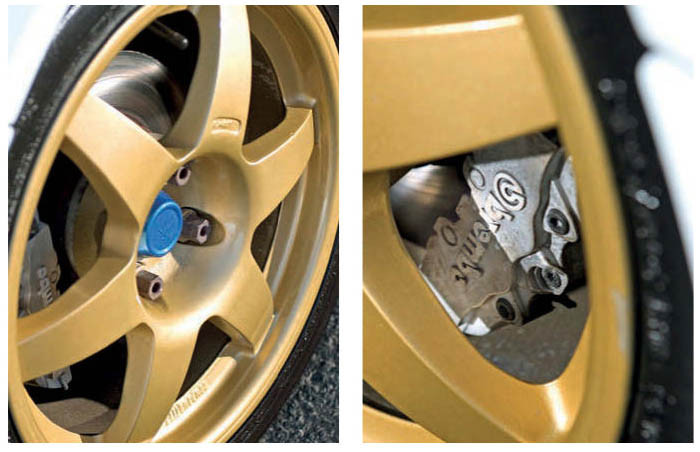
Wheel style is always a personal choice, but we’d suggest sticking with 17s for the road and dropping to 16s for the track – there’s plenty of choice for either available in the 4x108 Ford fitment and aim for an offset as close to the stock ET47.5 as you can.
BRAKES
As well as breaking the mould for handling, the ST170 was the first time we saw decent brakes on a sporty Ford hatch too. The ST’s front and rear brakes feature 300mm and 280mm discs respectively, compared to the 258mm and 253mm items on the regular Mk1 Focus. This, along with four-channel ABS, traction control, and Electronic Stability Programme, results in excellent braking performance. However, upgrading to braided brake lines can help reduce brake-line distortion and provides a better pedal feel – especially after heavy and repeated use when on track. Performance brake pads from the likes of EBC or similar are also a wise investment. Cross-drilled discs can help with heat dissipation and further improve braking and provide a formidable setup while retaining the factory calipers.
For those looking to upgrade further, ditching the stock calipers and fitting Brembos and 324mm front discs from a Focus RS can prove a cost-effective upgrade. Or four- or six-pot calipers from AP Racing will offer even greater stopping power but come at a cost. They really will give the best braking performance though, as well as provide a clear statement of intent when pulling up at a show or track day.
CONTACTS
- COLLINS PERFORMANCE ENGINEERING (CPE) collinsperformance.com
- PUMASPEED pumaspeed.co.uk
- AIRTEC MOTORSPORT airtecmotorsport.com
- BURTON POWER burtonpower.com

